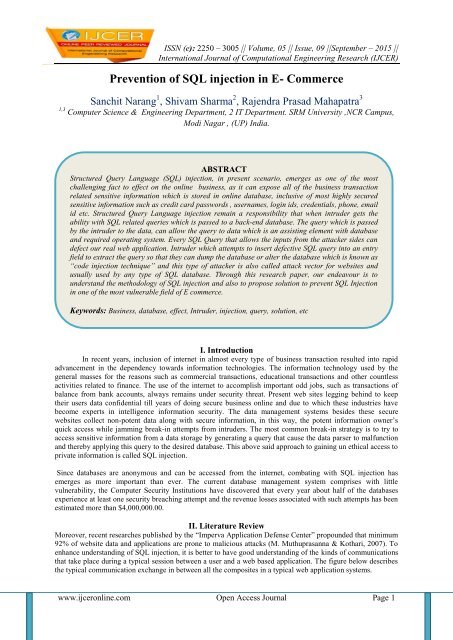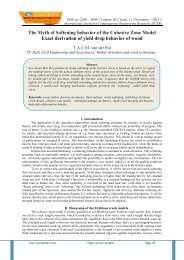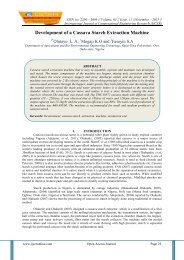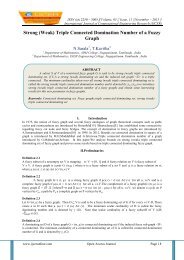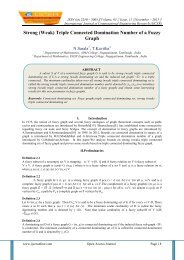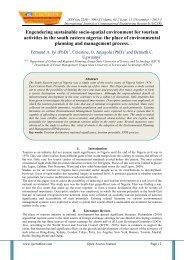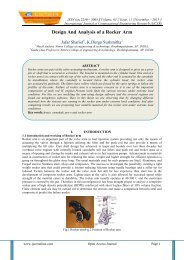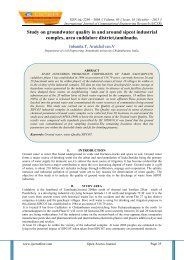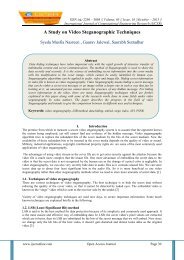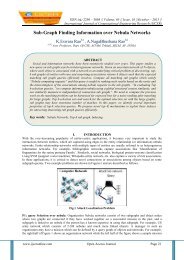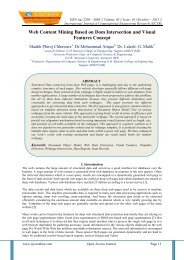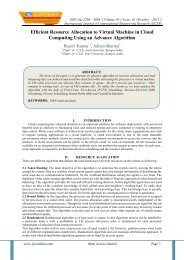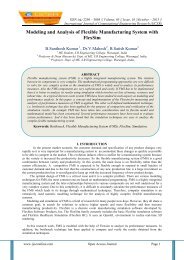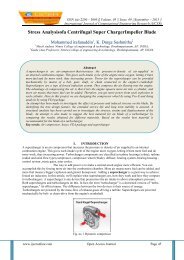Prevention of SQL injection in E- Commerce
Create successful ePaper yourself
Turn your PDF publications into a flip-book with our unique Google optimized e-Paper software.
ISSN (e): 2250 – 3005 || Volume, 05 || Issue, 09 ||September – 2015 ||<br />
International Journal <strong>of</strong> Computational Eng<strong>in</strong>eer<strong>in</strong>g Research (IJCER)<br />
<strong>Prevention</strong> <strong>of</strong> <strong>SQL</strong> <strong><strong>in</strong>jection</strong> <strong>in</strong> E- <strong>Commerce</strong><br />
Sanchit Narang 1 , Shivam Sharma 2 , Rajendra Prasad Mahapatra 3<br />
1,3 Computer Science & Eng<strong>in</strong>eer<strong>in</strong>g Department, 2 IT Department. SRM University ,NCR Campus,<br />
Modi Nagar , (UP) India.<br />
ABSTRACT<br />
Structured Query Language (<strong>SQL</strong>) <strong><strong>in</strong>jection</strong>, <strong>in</strong> present scenario, emerges as one <strong>of</strong> the most<br />
challeng<strong>in</strong>g fact to effect on the onl<strong>in</strong>e bus<strong>in</strong>ess, as it can expose all <strong>of</strong> the bus<strong>in</strong>ess transaction<br />
related sensitive <strong>in</strong>formation which is stored <strong>in</strong> onl<strong>in</strong>e database, <strong>in</strong>clusive <strong>of</strong> most highly secured<br />
sensitive <strong>in</strong>formation such as credit card passwords , usernames, log<strong>in</strong> ids, credentials, phone, email<br />
id etc. Structured Query Language <strong><strong>in</strong>jection</strong> rema<strong>in</strong> a responsibility that when <strong>in</strong>truder gets the<br />
ability with <strong>SQL</strong> related queries which is passed to a back-end database. The query which is passed<br />
by the <strong>in</strong>truder to the data, can allow the query to data which is an assist<strong>in</strong>g element with database<br />
and required operat<strong>in</strong>g system. Every <strong>SQL</strong> Query that allows the <strong>in</strong>puts from the attacker sides can<br />
defect our real web application. Intruder which attempts to <strong>in</strong>sert defective <strong>SQL</strong> query <strong>in</strong>to an entry<br />
field to extract the query so that they can dump the database or alter the database which is known as<br />
“code <strong><strong>in</strong>jection</strong> technique” and this type <strong>of</strong> attacker is also called attack vector for websites and<br />
usually used by any type <strong>of</strong> <strong>SQL</strong> database. Through this research paper, our endeavour is to<br />
understand the methodology <strong>of</strong> <strong>SQL</strong> <strong><strong>in</strong>jection</strong> and also to propose solution to prevent <strong>SQL</strong> Injection<br />
<strong>in</strong> one <strong>of</strong> the most vulnerable field <strong>of</strong> E commerce.<br />
Keywords: Bus<strong>in</strong>ess, database, effect, Intruder, <strong><strong>in</strong>jection</strong>, query, solution, etc<br />
I. Introduction<br />
In recent years, <strong>in</strong>clusion <strong>of</strong> <strong>in</strong>ternet <strong>in</strong> almost every type <strong>of</strong> bus<strong>in</strong>ess transaction resulted <strong>in</strong>to rapid<br />
advancement <strong>in</strong> the dependency towards <strong>in</strong>formation technologies. The <strong>in</strong>formation technology used by the<br />
general masses for the reasons such as commercial transactions, educational transactions and other countless<br />
activities related to f<strong>in</strong>ance. The use <strong>of</strong> the <strong>in</strong>ternet to accomplish important odd jobs, such as transactions <strong>of</strong><br />
balance from bank accounts, always rema<strong>in</strong>s under security threat. Present web sites legg<strong>in</strong>g beh<strong>in</strong>d to keep<br />
their users data confidential till years <strong>of</strong> do<strong>in</strong>g secure bus<strong>in</strong>ess onl<strong>in</strong>e and due to which these <strong>in</strong>dustries have<br />
become experts <strong>in</strong> <strong>in</strong>telligence <strong>in</strong>formation security. The data management systems besides these secure<br />
websites collect non-potent data along with secure <strong>in</strong>formation, <strong>in</strong> this way, the potent <strong>in</strong>formation owner‟s<br />
quick access while jamm<strong>in</strong>g break-<strong>in</strong> attempts from <strong>in</strong>truders. The most common break-<strong>in</strong> strategy is to try to<br />
access sensitive <strong>in</strong>formation from a data storage by generat<strong>in</strong>g a query that cause the data parser to malfunction<br />
and thereby apply<strong>in</strong>g this query to the desired database. This above said approach to ga<strong>in</strong><strong>in</strong>g un ethical access to<br />
private <strong>in</strong>formation is called <strong>SQL</strong> <strong><strong>in</strong>jection</strong>.<br />
S<strong>in</strong>ce databases are anonymous and can be accessed from the <strong>in</strong>ternet, combat<strong>in</strong>g with <strong>SQL</strong> <strong><strong>in</strong>jection</strong> has<br />
emerges as more important than ever. The current database management system comprises with little<br />
vulnerability, the Computer Security Institutions have discovered that every year about half <strong>of</strong> the databases<br />
experience at least one security breach<strong>in</strong>g attempt and the revenue losses associated with such attempts has been<br />
estimated more than $4,000,000.00.<br />
II. Literature Review<br />
Moreover, recent researches published by the “Imperva Application Defense Center” propounded that m<strong>in</strong>imum<br />
92% <strong>of</strong> website data and applications are prone to malicious attacks (M. Muthuprasanna & Kothari, 2007). To<br />
enhance understand<strong>in</strong>g <strong>of</strong> <strong>SQL</strong> <strong><strong>in</strong>jection</strong>, it is better to have good understand<strong>in</strong>g <strong>of</strong> the k<strong>in</strong>ds <strong>of</strong> communications<br />
that take place dur<strong>in</strong>g a typical session between a user and a web based application. The figure below describes<br />
the typical communication exchange <strong>in</strong> between all the composites <strong>in</strong> a typical web application systems.<br />
www.ijceronl<strong>in</strong>e.com Open Access Journal Page 1
<strong>Prevention</strong> <strong>of</strong> <strong>SQL</strong> <strong><strong>in</strong>jection</strong>…<br />
After review<strong>in</strong>g numerous electronic journals, articles from IEEE/FCI journals and gathered <strong>in</strong>formation<br />
provides sufficient knowledge about <strong>SQL</strong> <strong><strong>in</strong>jection</strong>, it‟s attack<strong>in</strong>g methodology and its prevention. The<br />
successive review <strong>of</strong> dist<strong>in</strong>ctive papers is presented herewith.<br />
Gregory T. Buehrer, Bruce W. Weide, and Paolo A. G. Sivilotti, <strong>in</strong> the research paper “Us<strong>in</strong>g Parse<br />
Tree Validation to Prevent <strong>SQL</strong> Injection Attacks” publishes there commendable work <strong>in</strong> 2005. The techniques<br />
for sql <strong><strong>in</strong>jection</strong> discovery seems impressive as this paper also covered the <strong>SQL</strong> parse tree validation very<br />
specifically which is mentionable.<br />
Zhendong Su and Gary Wassermann, <strong>in</strong> 2006 published their research <strong>in</strong> <strong>SQL</strong> <strong><strong>in</strong>jection</strong> entitled “The<br />
Essence <strong>of</strong> Command Injection Attacks <strong>in</strong> Web Applications” and covered the specific methods to check and<br />
sanitize <strong>in</strong>put query us<strong>in</strong>g <strong>SQL</strong>CHECK, it use the augmented questions and <strong>SQL</strong>CHECK grammar to validate<br />
query.<br />
Stephen Thomas and Laurie Williams, worked so long <strong>in</strong> the field <strong>of</strong> <strong>SQL</strong> <strong><strong>in</strong>jection</strong> and <strong>in</strong> 2007, <strong>in</strong> their<br />
research paper, entitled “Automated Protection <strong>of</strong> PHP Applications aga<strong>in</strong>st <strong>SQL</strong>-<strong><strong>in</strong>jection</strong> Attacks” they<br />
covered an authentic scheme to protect application automatically from <strong>SQL</strong> <strong><strong>in</strong>jection</strong> <strong>in</strong>trusion. This authentic<br />
approach comb<strong>in</strong>es static, dynamic analysis and <strong>in</strong>telligent code re-eng<strong>in</strong>eer<strong>in</strong>g to secure exist<strong>in</strong>g properties.<br />
Ke Wei, M. Muthuprasanna & Suraj Kothari <strong>in</strong> 2007, published their work entitled “Prevent<strong>in</strong>g <strong>SQL</strong> Injection<br />
Attacks <strong>in</strong> Stored Procedures” and through this they provides a novel approach to shield the stored procedures<br />
from attack and detect <strong>SQL</strong> <strong><strong>in</strong>jection</strong> from websites. Their method <strong>in</strong>cludes runtime check with subsequent<br />
application code analysis to elim<strong>in</strong>ate vulnerability to attack. The key method beh<strong>in</strong>d this vulnerability attack is<br />
that it modifies the composition <strong>of</strong> the orig<strong>in</strong>al <strong>SQL</strong> statement and identifies the <strong>SQL</strong> <strong><strong>in</strong>jection</strong> attack. The<br />
process is divided <strong>in</strong> two <strong>in</strong>stalments, one is <strong>of</strong>f-l<strong>in</strong>e and another one is run-time <strong>in</strong> real time basis. In the <strong>of</strong>fl<strong>in</strong>e<br />
phase, previously stored procedures uses a parser to pre-process and detect <strong>SQL</strong> statements <strong>in</strong> the work<strong>in</strong>g<br />
call for run-time analysis but <strong>in</strong> the run-time phase, the technique monitors all run-time generated <strong>SQL</strong> queries<br />
related with the user <strong>in</strong>put and checks these with the orig<strong>in</strong>al structure <strong>of</strong> the <strong>SQL</strong> statement after gett<strong>in</strong>g <strong>in</strong>put<br />
from the user.<br />
III. Pr<strong>in</strong>ciple<br />
Web based applications have <strong>SQL</strong> <strong><strong>in</strong>jection</strong> susceptibilities as they do not dis<strong>in</strong>fect the <strong>in</strong>puts they use to<br />
construct fabricated desired output. The gathered code is rema<strong>in</strong>s from an onl<strong>in</strong>e storage system. The web-site<br />
provides user‟s <strong>in</strong>put field to allow the user to keep their secret <strong>in</strong>formation, such as credit card/debit card<br />
password, etc. which user can use for future purchases conveniently. Replace method used to escape the quotes<br />
so that any s<strong>in</strong>gle quote characters <strong>in</strong> the <strong>in</strong>put are considered to be literal and not a str<strong>in</strong>g delimiters. Replace<br />
method is <strong>in</strong>tended to block attacks by prevent<strong>in</strong>g an attacker from end<strong>in</strong>g the str<strong>in</strong>g and add<strong>in</strong>g <strong>SQL</strong> <strong><strong>in</strong>jection</strong><br />
code. Although, card-type is a number<strong>in</strong>g column, if an attacker passes 2 OR 1-1 as the card type, all account<br />
numbers <strong>in</strong> the database will be returned and displayed on the screen.<br />
www.ijceronl<strong>in</strong>e.com Open Access Journal Page 2
<strong>Prevention</strong> <strong>of</strong> <strong>SQL</strong> <strong><strong>in</strong>jection</strong>…<br />
Fig: System composition <strong>of</strong> <strong>SQL</strong>CHECK<br />
IV. Methodology:<br />
<strong>SQL</strong> <strong><strong>in</strong>jection</strong> is widely used hack<strong>in</strong>g technique, <strong>in</strong> which the <strong>in</strong>truder adds <strong>SQL</strong> statements us<strong>in</strong>g a web<br />
application as <strong>in</strong>put fields to access to the secret users resources and due to lack <strong>of</strong> <strong>in</strong>put Validation <strong>in</strong> web<br />
applications causes <strong>in</strong>truders to be successful <strong>in</strong> hack<strong>in</strong>g.<br />
With above said technique, we can assume that a Web application receives a “http//” request from a user client<br />
as Input and generates a <strong>SQL</strong> statement as output for the back-End database server. For example an<br />
adm<strong>in</strong>istrator will be authenticated after provid<strong>in</strong>g <strong>in</strong>put as -<br />
Typ<strong>in</strong>g: employee id - 0112<br />
and password =adm<strong>in</strong>, configure<br />
That describes a log<strong>in</strong> by a suspecious user exploit<strong>in</strong>g sql Injection vulnerability .<br />
Usually, it is structured <strong>in</strong> three phases,<br />
(1) An Intruder sends the malicious “http//” request to the Web application,<br />
(2). Generates the sql statement,<br />
(3). Dedicatedly Deposited the sql statement to the back end database.<br />
Fig: Example methodology <strong>of</strong> <strong>SQL</strong> Injection.<br />
www.ijceronl<strong>in</strong>e.com Open Access Journal Page 3
<strong>Prevention</strong> <strong>of</strong> <strong>SQL</strong> <strong><strong>in</strong>jection</strong>…<br />
As per the pr<strong>in</strong>ciple, they track through the program and the substr<strong>in</strong>gs received from user <strong>in</strong>put and filters that<br />
substr<strong>in</strong>gs immediately. The endeavour beh<strong>in</strong>d these program rema<strong>in</strong>s block<strong>in</strong>g the malicious queries <strong>in</strong> which<br />
the <strong>in</strong>com<strong>in</strong>g substr<strong>in</strong>gs changes the syntactic morphology <strong>of</strong> the rest <strong>of</strong> the queries. They use the metadata to<br />
analyse user‟s <strong>in</strong>put which displayed as ( „_‟ ) and ( „_,‟ ) to mark the end<strong>in</strong>g and beg<strong>in</strong>n<strong>in</strong>g <strong>of</strong> the each user<br />
<strong>in</strong>com<strong>in</strong>g str<strong>in</strong>g. This said metadata passes the <strong>in</strong>com<strong>in</strong>g str<strong>in</strong>g through an assignments, and concatenations, so<br />
that when a query is ready to be sent to the database, it has a match<strong>in</strong>g pairs <strong>of</strong> markers that identify the<br />
substr<strong>in</strong>g from the <strong>in</strong>put. These annotated queries called an augmented query. To construct a parser for the<br />
augmented grammar and attempt to parse each augmented query Steve use a parse generator. Query meets the<br />
syntactic constra<strong>in</strong>ts and considered legitimate if it passes successfully. Else, it fails the syntactic constra<strong>in</strong>ts and<br />
<strong>in</strong>terprets it as an <strong>SQL</strong> <strong><strong>in</strong>jection</strong> attack.<br />
As per the system architecture <strong>of</strong> the check<strong>in</strong>g system shows <strong>in</strong> Figure above, the Grammar <strong>of</strong> the outgo<strong>in</strong>g<br />
data language is used to build <strong>SQL</strong>CHECK and a policy mentioned permitted syntactic forms, it resides on the<br />
web server and taps generated queries. In spite <strong>of</strong> the <strong>in</strong>put‟s source, each <strong>in</strong>put which is to be passed <strong>in</strong>to some<br />
query, gets augmented with the meta-characters („_‟) and („_,‟).<br />
F<strong>in</strong>ally application creates augmented queries, which <strong>SQL</strong>CHEKCK attempts to parse, and if a query parses<br />
successfully, <strong>SQL</strong>CHECK sends it the meta-data to the database, else the query get rejected.<br />
.<br />
V. Observation<br />
Moreover, developers deploy defensive cod<strong>in</strong>g but they are not enough to stop <strong>SQL</strong> <strong><strong>in</strong>jection</strong>s to web<br />
applications, that is why researchers have proposed some <strong>of</strong> tools to assist developers to prevent there. It is<br />
mentionable that there are more approaches which have not implemented a tool yet. In this paper, we emphasize<br />
more on tools and less on techniques. Huang and colleagues propose WAVES, a black box technique for test<strong>in</strong>g<br />
web applications for <strong>SQL</strong> <strong><strong>in</strong>jection</strong> vulnerabilities. The tool identify all po<strong>in</strong>ts a web application that can be<br />
used to <strong>in</strong>ject <strong>SQL</strong>IAs. It builds attacks that target these po<strong>in</strong>ts and monitors the application how response to the<br />
attacks by utilize mach<strong>in</strong>e learn<strong>in</strong>g.<br />
VI. Conclusion<br />
<strong>SQL</strong> <strong><strong>in</strong>jection</strong> <strong>in</strong>trusions rema<strong>in</strong> a serious problem for developers as they can be used to break <strong>in</strong>to supposedly<br />
secure systems and copy, alter, or destroy data. It becomes very easy to leave yourself vulnerable to these<br />
attacks, regard<strong>in</strong>g <strong>of</strong> which version <strong>of</strong> .NET. In fact, you don't even need to be us<strong>in</strong>g .NET to be susceptible to<br />
<strong>SQL</strong> <strong><strong>in</strong>jection</strong> attacks. Any further implecations that queries a database us<strong>in</strong>g user- entered data set, <strong>in</strong>clud<strong>in</strong>g<br />
W<strong>in</strong>dows Forms applications is a potential target <strong>of</strong> an <strong><strong>in</strong>jection</strong> attack.<br />
Protect<strong>in</strong>g user aga<strong>in</strong>st <strong>SQL</strong> <strong><strong>in</strong>jection</strong> attacks is less difficult. Uses which are immune to <strong>SQL</strong> <strong><strong>in</strong>jection</strong> attacks<br />
validate and sanitize all user <strong>in</strong>put, never use dynamic <strong>SQL</strong> <strong><strong>in</strong>jection</strong>, perform us<strong>in</strong>g an account with few<br />
privileges, hash or encrypt their secrets, and present error messages that reveal little if no useful <strong>in</strong>formation to<br />
the hacker. By follow<strong>in</strong>g a multi-layered approach to prevention you can be assured that if one defence is<br />
circumvented, you will still be protected. For <strong>in</strong>formation on test<strong>in</strong>g your application for <strong><strong>in</strong>jection</strong><br />
vulnerabilities, see the sidebar "Injection Test<strong>in</strong>g".<br />
References<br />
[1] W Ke Wei, M. Muthuprasanna, Suraj Kothari , Dept. <strong>of</strong> Electrical and Computer Eng<strong>in</strong>eer<strong>in</strong>g , Iowa State University Ames, IA –<br />
50011 ,Email: {weike,muthu,kothari}@iastate.edu<br />
[2] http://www.appsec<strong>in</strong>c.com/presentations/Manipulat<strong>in</strong>g <strong>SQL</strong> Server Us<strong>in</strong>g <strong>SQL</strong> Injection.pdf, White Paper.<br />
[3] William G.J. Halfond, Jeremy Viegas, and Alessandro Orso College <strong>of</strong> Comput<strong>in</strong>g Georgia Institute <strong>of</strong> Technology<br />
{whalfond|jeremyv|orso}@cc.gatech.edu<br />
[4] Z. Su and G. Wassermann. The Essence <strong>of</strong> Command Injection Attacks <strong>in</strong> Web Applications. In The 33rd Annual Symposium on<br />
Pr<strong>in</strong>ciples <strong>of</strong> Programm<strong>in</strong>g Languages (POPL 2006), Jan. 2006.<br />
[5] F. Valeur, D. Mutz, and G. Vigna. A Learn<strong>in</strong>g-Based Approach to the Detection <strong>of</strong> <strong>SQL</strong> Attacks. In Proceed<strong>in</strong>gs <strong>of</strong> the<br />
Conference on Detection <strong>of</strong> Intrusions and Malware and Vulnerability Assessment (DIMVA), Vienna, Austria, July 2005.<br />
www.ijceronl<strong>in</strong>e.com Open Access Journal Page 4


